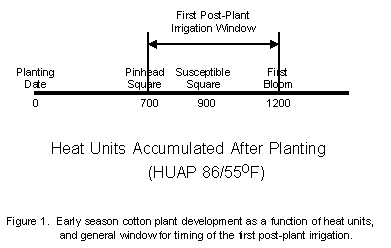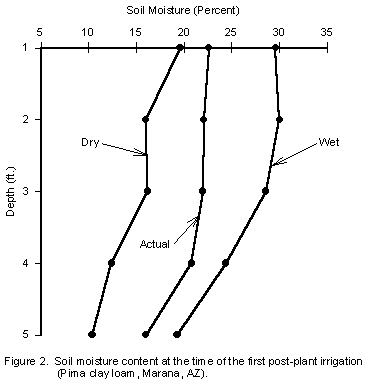Timing the First Post-Plant Irrigation
(Publication az1204)
(PDF file version, 34KB)
by Jeffrey C. Silvertooth, Extension Agronomist - Cotton
Paul W. Brown, Extension Biometerologist
Steven H. Husman, Extension Agent
Ed Martin, Extension Irrigation Specialist
After selecting a variety, planting, and establishing a stand, the next major management decision for a young crop involves the timing of the first post-plant irrigation. If a crop was dry planted and watered-up, one or two irrigations have probably been used in establishing a stand. Therefore, what we are referring to here is the first irrigation needed beyond starting a stand, or the first in-season irrigation. This irrigation event is important in that it begins the progression of irrigations which serve as the life blood of a desert cotton crop, and it can also impact the crop for the rest of the season. Conventional wisdom in the cotton producing communities of Arizona commonly includes the belief that irrigating a crop too early will create vegetative plants and a difficult to manage crop. Many people contend that stressing a cotton crop early is good in that it prevents vegetative growth, encourages deeper rooting, and promotes early fruiting.
We have conducted a series of field experiments in Arizona since 1992 evaluating the effects of the first irrigation on subsequent growth and yield. There are several things which can be drawn from the results of these experiments. One conclusion would be that irrigating too early does not serve to benefit growth and yield, and secondly, delaying the first irrigation too late can hurt young plants enough that they can be effected all season long, even to the point of decreasing yields. Early or late timing of the first in-season irrigation can impact earliness, yields, and profits. Logical questions concerning the timing of the first irrigation are: “what is too early?”and “what is too late?”. While this decision will always depend on a number of factors specific to each field or case, we can offer a general strategy which may be useful in approaching the timing of this first irrigation.
Proposed Strategy
The diagram in Figure 1 outlines early cotton plant development in terms of important stages of growth and associated heat units accumulated after planting (HUAP, 86/55° F). As noted in this figure, first pinhead squares (PHS) should appear by about 700 HUAP at nodes 5, 6, or 7. Matchhead squares (MHS), those squares just large enough to have sepals separating at the top and showing the white tissue of the flower petals, will be present at about 900 HUAP, providing early squares were set and retained at about 700 HUAP. First blooms (FB) may be set at about 1200 HUAP if PHS and MHS were set and held on time. Therefore, we can follow early and important stages of crop development in terms HUAP and predict when these critical transitional events should occur.
Similarly, we can use the HUAP and early growth stage approach to time the first irrigations. As you can see from Figure 1, we can outline a Window for the First Irrigation as 700 to 1200 HUAP, or PHS to FB. In general, an optimum point or target seems to be about 800 - 1000 HUAP a period surrounding MHS occurrence.
Another important aspect of this consideration is that of the plant-available soil moisture which is present. Figure 2 (a Pima clay loam at Marana, AZ) outlines soil moisture content to a profile depth of five feet. The “dry” line indicates the permanent wilting point and the “wet” line indicates the field capacity for that soil. The area between these two lines describes the plant-available water, which should be depleted to approximately 50% before initiating irrigations.
Implications
- Fields should be monitored for the development of the first PHS. In some cases, such as coarse textured and/or shallow soils, the first post-plant irrigation may be needed as early as 700 HUAP if soils are drying out excessively.
- Fields may reach a need for the first irrigation early if weather conditions are excessively hot, dry and/or windy; or be delayed if weather conditions are cool and wet.
- A general target for the first irrigation may be approximately 900 HUAP, around which a large number of acres could be managed.
- Delaying the first irrigation beyond 1200 HUAP will likely damage young plants, which can impact earliness and yield.
- Soil moisture levels, particularly in the top 2 ft., should also be monitored along with HU accumulations and crop development.
Issued in furtherance of Cooperative Extension work, acts of May 8 and June 30, 1914, in cooperation with the U.S. Department of Agriculture, James A. Christenson, Director Cooperative Extension, College of Agriculture and Life Sciences, The University of Arizona.
The University of Arizona is an equal opportunity, affirmative action institution. The University does not discriminate on the basis of race, color, religion, sex, national origin, age, disability, veteran status, or sexual orientation in its programs and activities.
Any products, services, or organizations that are
mentioned, shown, or indirectly implied in this web document do not imply
endorsement by The University of Arizona.
Information provided by:
Jeffrey C. Silvertooth, silver@ag.arizona.edu Extension Agronomist - Cotton,
Paul W. Brown, Extension Biometerologist,
Steven H. Husman, Extension Agent,
Ed Martin, Extension Irrigation Specialist,
College of Agriculture, The University of Arizona.
Material written February 2001.
Crop Mgmt | Soil Mgmt | Irrigation | Varieties | Cotton Comments
Home | Cotton | Advisories
document located at: http://cals.arizona.edu/crops/cotton/cropmgt/post_plant_irrigation.html
Copyright © 2001 University of Arizona,
College of Agriculture and Life Sciences
Webmaster: Al Fournier (acis@ag.arizona.edu)

